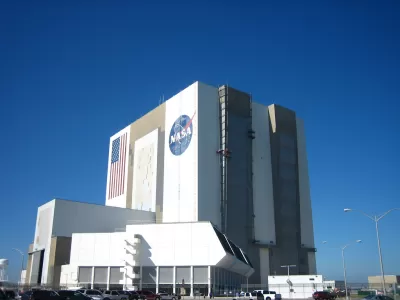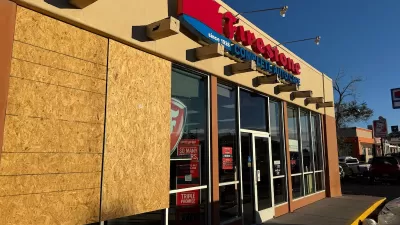Caught between the end of the space shuttle and the potential rise of private sector spaceflight, Cape Canaveral and the Kennedy Space Center present a unique land use challenge.

As the literal launching pad for some of America's most famous achievements, Cape Canaveral now faces an uncertain future. Congress is not about to approve new manned spaceflight programs, and private space companies are still catching up to where NASA was almost 50 years ago. Meanwhile, the Kennedy Space Center lies mostly silent.
Anthony Flint discusses NASA's current multi-dimensional plans for the Florida expanse. While tourism is still a big draw, "NASA clearly wasn't ready to cede this territory completely over to nostalgia. It's all part of a larger political battle, almost willing Cape Canaveral into the future [...] Much of the activity has to do with a fundamental choice that NASA has made: to make facilities available to private sector space initiatives such as Space X."
There's also a green aspect to all of this. "Re-purposing buildings is a common theme here, for both financial and environmental efficiency. NASA dutifully went for LEED platinum rating at the Propellants Maintenance Facility. Over by the area used for testing vehicles on a simulated surface of the moon, solar arrays are being put up, joining a giant solar farm installed in 2008." We'll have to wait and see what's in store for the nation's spaceport.
FULL STORY: The Land-Use Reinvention of Cape Canaveral

Alabama: Trump Terminates Settlements for Black Communities Harmed By Raw Sewage
Trump deemed the landmark civil rights agreement “illegal DEI and environmental justice policy.”

Planetizen Federal Action Tracker
A weekly monitor of how Trump’s orders and actions are impacting planners and planning in America.

Why Should We Subsidize Public Transportation?
Many public transit agencies face financial stress due to rising costs, declining fare revenue, and declining subsidies. Transit advocates must provide a strong business case for increasing public transit funding.

Understanding Road Diets
An explainer from Momentum highlights the advantages of reducing vehicle lanes in favor of more bike, transit, and pedestrian infrastructure.

New California Law Regulates Warehouse Pollution
A new law tightens building and emissions regulations for large distribution warehouses to mitigate air pollution and traffic in surrounding communities.

Phoenix Announces Opening Date for Light Rail Extension
The South Central extension will connect South Phoenix to downtown and other major hubs starting on June 7.
Urban Design for Planners 1: Software Tools
This six-course series explores essential urban design concepts using open source software and equips planners with the tools they need to participate fully in the urban design process.
Planning for Universal Design
Learn the tools for implementing Universal Design in planning regulations.
Caltrans
Smith Gee Studio
Institute for Housing and Urban Development Studies (IHS)
City of Grandview
Harvard GSD Executive Education
Toledo-Lucas County Plan Commissions
Salt Lake City
NYU Wagner Graduate School of Public Service





























